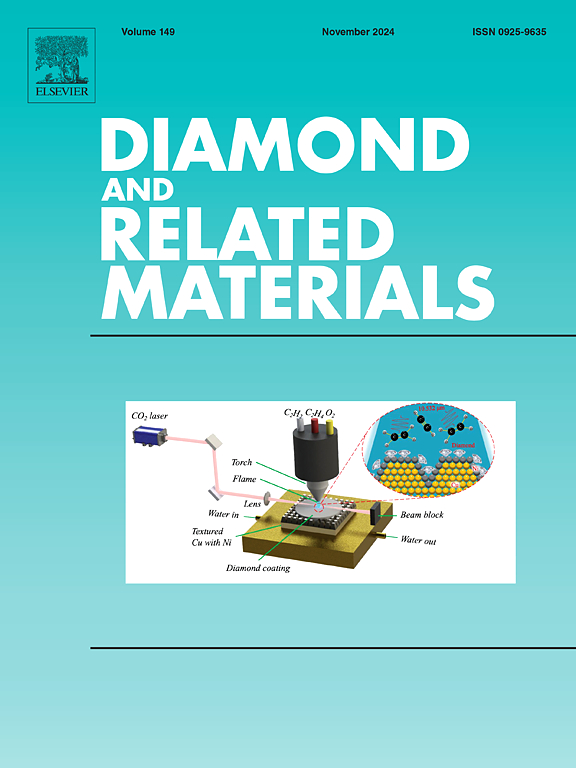Impact of acid etching on surfaces and near-surface region in nitrogen plasma terminated polycrystalline diamond
IF 4.3
3区 材料科学
Q2 MATERIALS SCIENCE, COATINGS & FILMS
引用次数: 0
Abstract
In this study, the influence of tri-acid: HClO4:H2SO4:HNO3 (1:3:4) etching on the surface and near-surface chemical properties of radio frequency (RF) nitrogen plasma terminated polycrystalline diamond (PCD) surfaces is reported. From the C(1s) and N(1s) high resolution X-ray photoelectron spectroscopy (HR-XPS) measured as a function of photon energy, it is clearly shown that acid etching reduced the thickness of the disordered C(sp2) layer created by the nitrogen plasma treatment exposing an upper surface of a larger C(sp3) character alongside the formation of C-Ox bonds. This is accompanied by a reduction in the nitrogen surface concentration and the N(1s) XP peak full width at half maximum (FWHM), suggesting a more homogeneous nitrogen bonding to the diamond surface. High resolution electron energy loss spectroscopy (HREELS) shows that NH(ads) species produced by the plasma processes are preferentially etched alongside the formation of C=O(ads), C-O(ads), and COOC(ads) species, whereas hydrogen is bonded in various CHy(ads) configurations. The C K-edge NEXAFS spectra show characteristic peaks in the pre-edge structure clearly associated with nitrogen bonding. Following acid etching, the intensities of peaks related to defect states are reduced, whereas the diamond second band-gap at 302.4 eV increases in intensity. N K-edge NEXAFS of the nitrogen plasma terminated surfaces show peaks associated to C-N(ads) and C=N(ads) bonding, which acid etching results in the preferred depopulation of C=N(ads) bonds.

酸蚀对氮等离子体端部聚晶金刚石表面和近表面区域的影响
本研究报道了三酸:HClO4:H2SO4:HNO3(1:3:4)蚀刻对射频(RF)氮等离子体端接聚晶金刚石(PCD)表面和近表面化学性质的影响。从C(1s)和N(1s)的高分辨率x射线光电子能谱(HR-XPS)作为光子能量的函数测量,清楚地表明,酸蚀刻降低了氮等离子体处理产生的无序C(sp2)层的厚度,暴露出较大的C(sp3)特征的上表面以及C- ox键的形成。这伴随着氮表面浓度的降低和N(1s) XP峰半峰全宽(FWHM),表明氮与金刚石表面的结合更加均匀。高分辨率电子能量损失谱(HREELS)显示,等离子体过程产生的NH(ads)物质优先蚀刻,同时形成C=O(ads)、C-O(ads)和COOC(ads)物质,而氢以各种CHy(ads)构型成键。C - K-edge NEXAFS光谱显示出与氮键明显相关的前边缘结构的特征峰。酸蚀后,与缺陷态相关的峰强度降低,而302.4 eV的金刚石第二带隙强度增加。氮等离子体端部的N k边NEXAFS显示与C-N(ads)和C=N(ads)键相关的峰,酸蚀导致C=N(ads)键优先减少。
本文章由计算机程序翻译,如有差异,请以英文原文为准。
求助全文
约1分钟内获得全文
求助全文
来源期刊

Diamond and Related Materials
工程技术-材料科学:综合
CiteScore
6.00
自引率
14.60%
发文量
702
审稿时长
2.1 months
期刊介绍:
DRM is a leading international journal that publishes new fundamental and applied research on all forms of diamond, the integration of diamond with other advanced materials and development of technologies exploiting diamond. The synthesis, characterization and processing of single crystal diamond, polycrystalline films, nanodiamond powders and heterostructures with other advanced materials are encouraged topics for technical and review articles. In addition to diamond, the journal publishes manuscripts on the synthesis, characterization and application of other related materials including diamond-like carbons, carbon nanotubes, graphene, and boron and carbon nitrides. Articles are sought on the chemical functionalization of diamond and related materials as well as their use in electrochemistry, energy storage and conversion, chemical and biological sensing, imaging, thermal management, photonic and quantum applications, electron emission and electronic devices.
The International Conference on Diamond and Carbon Materials has evolved into the largest and most well attended forum in the field of diamond, providing a forum to showcase the latest results in the science and technology of diamond and other carbon materials such as carbon nanotubes, graphene, and diamond-like carbon. Run annually in association with Diamond and Related Materials the conference provides junior and established researchers the opportunity to exchange the latest results ranging from fundamental physical and chemical concepts to applied research focusing on the next generation carbon-based devices.
 求助内容:
求助内容: 应助结果提醒方式:
应助结果提醒方式:


